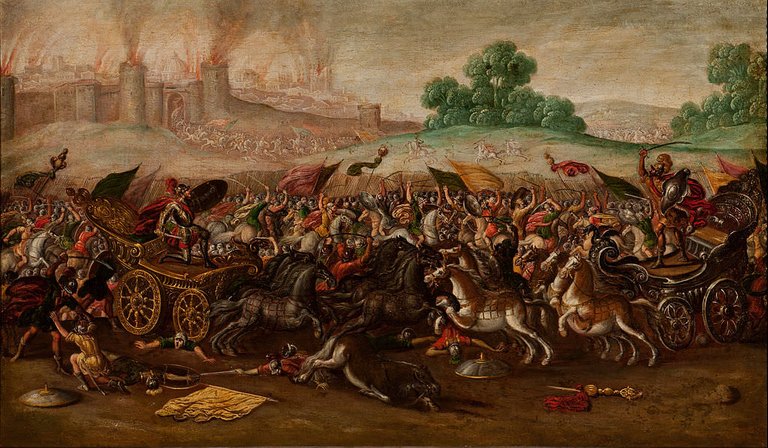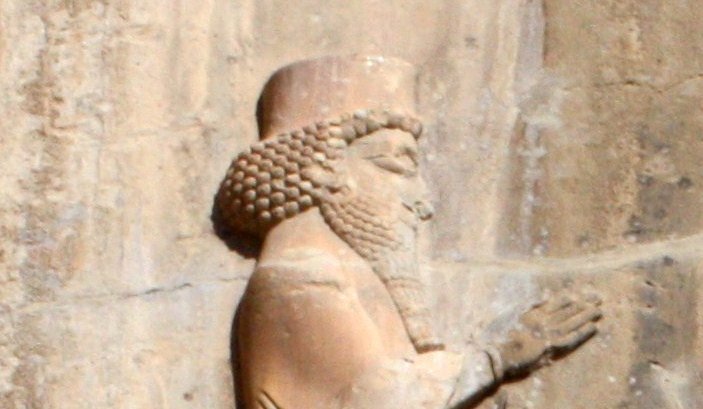
In the preceding article in this series, we chose the Exodus as the Alpha of ancient Israelite history, a moment in time from which to begin our reconstruction of Biblical chronology. Now we need an Omega to which we can anchor the other end of the timeline. After the Exodus, the defining event in the history of ancient Israel is surely the destruction of the Temple of Solomon and the ensuing Babylonian Captivity. This tragedy marked the end of the Kingdom of Judah, which makes it the obvious choice for our Omega.
Curiously, in the conventional chronology there is still no consensus on the precise date of this epochal event, though there is now broad agreement that it occurred in either 587 or 586 BCE. William F Albright settled upon the earlier year, but Edwin R Thiele, Kenneth Kitchen and Gershon Galil all favoured the latter. Earlier scholars—eg James Ussher and Isaac Newton—dated this event to the year 588 BCE.
There is also a lack of consensus among the proponents of the Short Chronology. Emmet J Sweeney places this event in the reign of the Persian Emperor Artaxerxes III, whom he identifies with the Biblical King of Babylon Nebuchadnezzar. Lynn E Rose and Charles Ginenthal, however, adopted a much more radical realignment of the timescale and placed the sack of Jerusalem in the year 312 BCE. This date requires that Nebuchadnezzar, reputedly the greatest king in the history of Babylon, be nothing more than a provincial governor, a vassal of the ruling Macedonian Seleucids. I find this too large a pill to swallow. Sweeney’s reconstruction makes more sense to me (though Rose always claimed that he had very good astronomical records to support his paradigm).
Sweeney’s identification of Artaxerxes III and Nebuchadnezzar II is supported by the Book of Judith:

Before moving on, it should be noted that the Book of Judith, hitherto one of the most enigmatic of traditional Hebrew texts, takes on an altogether new significance in the light of the reconstruction proposed here. Judith is said to have lived during the time of a Nebuchadrezzar who is described as “King of Assyria.” No king of Assyria of this name is said to be known. Yet this Mesopotamian monarch is involved in events strikingly similar to those of his namesake who deported the people of Judah. He is said to have summoned the peoples of the west, including the Egyptians, to assist him in a war against the Medes. When this summons is ignored, he sets out, in his eighteenth year, to punish the traitors, who include Egyptians and Jews (Judith 2). This march to the west recalls the action taken by the other Nebuchadrezzar in the same region in his sixteenth year. Could it be that the Book of Judith provides an account of an otherwise obscure episode of the war against Nebuchadrezzar in the time of [King Zedekiah]—the war which we have identified as Arta Xerxes III’s second campaign against Egypt? One striking detail in the Book of Judith seems to confirm this. We are told that Nebuchadrezzar’s general Holofernes, whom Judith assassinates, had a eunuch named Bagoas (Judith 12:11). Yet Bagoas was the name of the trusted eunuch who assassinated Arta Xerxes III. Even more to the point, Arta Xerxes III also had a general named Holofernes. According to Diodorus, this Holofernes was a Cappadocian who accompanied Arta Xerxes III in his campaign against the Egyptians.237 Strange then that the Book of Judith would name as servants of Nebuchadrezzar two characters with names identical to two servants of Arta Xerxes III! (Sweeney 153-154. I emended Sweeney’s King Hezekiah to King Zedekiah, to whom he is clearly referring.)
In a series of bullet points, Sweeney summarizes the similarities between these two rulers, who are alleged to have been separated in time by more than two centuries:
- Both kings were rulers of Babylon, who clashed with Egypt.
- Arta Xerxes III’s first war against Egypt occurred in his eighth year, and ended in failure. Nebuchadrezzar’s first war against Egypt took place in his eighth or ninth year and apparently ended in failure.
- The Egyptian enemy of Arta Xerxes III was known as Nectanebo II. The Egyptian enemy of Nebuchadrezzar was known as Necho II.
- Arta Xerxes III’s second campaign against Egypt occurred in his sixteenth year and was successful. Nebuchadrezzar’s second campaign against Egypt occurred in his sixteenth or seventeenth year and resulted in the conquest of the Nile Kingdom.
- Arta Xerxes III’s Egyptian enemy Nectanebo II used Greek mercenaries against the Great King. Nebuchadrezzar’s Egyptian enemy Necho II used Greek mercenaries against him. (Sweeney 153)
Artaxerxes III reigned for twenty years from 358 to 338 BCE, a figure which Sweeney has some difficulty squaring with the forty-three years usually ascribed to Nebuchadnezzar. His second, successful campaign against Egypt took place in 343 BCE. Is this the true date of the fall of Jerusalem?

Seder Olam
In an earlier article in this series I examined the rabbinical chronological treatise known as the Seder Olam. I pointed out that the dates in this work are often at variance with the conventional dates in our history books. The destruction of the Temple of Solomon is set in the year 3338 AM (Anno Mundi), when the Babylonian Captivity began:

The Jews were in captivity in Babylon for 52 years before being freed by Cyrus. Cyrus continued his reign after he conquered Babylon for only three years. Then Ahasuerus ruled for 14 years, followed by Darius. In the second year of the reign of Darius, the Temple was rebuilt. (Johnson 4529-4536)
The Temple was finished in only four years, as it is written: “And this house was finished on the third day of the month Adar, which was in the sixth year of the reign of Darius the king.” Ezra 6: 15 (Johnson 4569-4574)
Rabbi Yose said: the Persian Empire continued to exist for [34] years after the new Temple was completed. The Grecian Empire ruled after Persia for 180 years. After the fall of the Grecian Empire, the Hasmonean Dynasty, starting under Judas Macabee, ruled Israel for 103 years. Then under Roman rule, the kingdom of Herod existed for 103 years before the Temple was destroyed. (Johnson 4725-4732)
(Johnson’s translation has 24 years for the Persian period after the completion of the Second Temple, but every other source I have consulted translates this passage as 34 years.)
Rabbi Yose’s timeline, then, for the period between the destruction of the First Temple and the destruction of the Second Temple is as follows:
| Years | Period or Event |
|---|---|
| - | Nebuchadnezzar destroys the Temple of Solomon in 3338 AM |
| 52 | Babylonian Captivity |
| 3 | Cyrus |
| 14 | Ahasuerus (Xerxes) |
| 1 | Darius’ 1st year |
| - | In Darius’ 2nd year construction of the Second Temple begins |
| 4 | Construction of the Second Temple |
| - | In Darius 6th the construction of the Second Temple is completed |
| 34 | Persian rule after the Second Temple is built |
| 180 | Grecian rule |
| 103 | Hasmonean rule |
| 103 | Herodian rule under the Romans |
| - | The Second Temple is destroyed |
Adding up, we see that 495 years elapsed between the destruction of the First Temple and the destruction of the Second Temple. Almost everyone—conventional historians and Short Chronologists alike—is in agreement that the latter took place in 70 CE. The destruction of the Temple of Solomon, then, is placed in the year 425 BCE.
In another passage of the Seder Olam, Rabbi Yose is again quoted:
Rabbi Yose also said: It was 70 years between the destruction of the First Temple to the dedication of the Second Temple. Add to that [420] years and we come to the 490 years of the prophecy which ended at the destruction of the Second Temple. (Johnson 4264-4270)
This places the destruction of Solomon’s Temple in the year 420 BCE. Other rabbinical sources (eg the Babylonian Talmud) lead to slightly different dates—423, 422, 421 BCE—but they are all in this general timeframe.
Whatever precise year we accept, it is more than 160 years later than the conventional date, and much closer to Sweeney’s date.
Ken Johnson, the translator of the Seder Olam comments on the above passage:
It has already been stated and verified that the period of the Persian rule covered 210 years; but here Yose is trying to make it 24 years [recte 34]. This difference is the famous 168 years that are missing from the Jewish calendar. This is why AD 2007 is 5766 AM instead of 5930 or 5934 AM. (Johnson 5702-5704)
210 minus 24 equals 186. Perhaps Johnson’s 168 years is a typo. But various figures are given for the number of missing years in the Jewish calendar: it all depends on which source you consult.
But what about 425 BCE? Could this be the true date of the destruction of Solomon’s Temple? It is certainly worth bearing in mind, but I still prefer Sweeney’s 343 BCE as a working model. We have already settled on 763 BCE as a working date for the Exodus, and the rabbinical date would only leave us 338 years to fit in all the intervening history. Sweeney’s 420 years is much more generous.
Let us, therefore, take 343 BCE as the date of the Fall of Jerusalem and the beginning of the Babylonian Captivity.
To be continued ...
References
- Ken Johnson, Ancient Seder Olam: A Christian Translation of the 2000-year-old Scroll, Kindle Edition, Biblefacts.org (2006)
- Emmet John Sweeney, The Ramessides, Medes and Persians, Ages in Alignment, Volume 4, Algora Publishing, New York (2007)
- Rabbi Dr I Epstein (editor), The Babylonian Talmud (Complete Soncino English Translation), The Soncino Press, London (1935-48)
Image Credits
- The Burning of Jerusalem by Nebuchadnezzar’s Army: Wikimedia Commons, Juan de la Corte (artist), Public Domain
- Emmet J Sweeney: © Society for Interdisciplinary Studies (SIS), Fair Use
- Artaxerxes III (Tomb at Persepolis): Wikimedia Commons, © Mardetanha, Creative Commons License
- Seder Olam: © 2006 Ken Johnson, Fair Use

Excellent publication, I am very glad that I can get some SBD and STEEM through this publication, it is well deserved because you always upload an amazing and very complete material, Greetings from Venezuela, faithful reader of you because I like to learn! Kisses, darling!
Extraordinary and very didactic the way to let us know these interesting facts, it is nice to read it.
Great article,good history!
Really extraordinary the way you present these important passages of the Bible, thank you.
I am very excited to know things about all the religions, Israel and others, I think they are very entertaining topics to discuss and where you learn a lot, I like this kind of content, Many blessings.
PS: Dublin is my dream city ♥
Thanks for sharing chronology religion history in font of us. I will wait for next part.
Nice history and great post my friend @harlotscure Congratulations!
I had not seen the first part, I just finished reading next to this and the only thing I have is that giving is the congratulations for an incredible job that you have done writing these publications, you really appreciate your effort in Steemit, Muchisimas Thank you and I wanted to ask you a question: When does the next part come out? Hahaha
I love this kind of series, it's too informative and a great help for those of us who do not know so much about the fall of Jerusalem, thank you very much my dear friend @harlotscurse I follow him since he made the Maraton di pisa and I am delighted with his good content, Many greetings and strong hug!
very nice history my big bro @harlotscurse i like post
Its a great publication and also its a good article.
very nice your post dear @harlotscorse....
thank you for sharing with us
i love your all postwonderful history my dear friend @harlotscurse
thank you for sharing your postwow, beautiful history,,,i like your post,,,, my dear friend @harlotscurse,,
Through this post we got to know many history. great writing.
💓💓Wow excellent story thanks for shere dear @harlotscurse I just #Upvote And #Resteem your post......???💓💓
Very good post👌👌 i like your all post dear @harlotscurse
I first time comment your post because you are very intelligent writer go ahead and do enjoy your life.......i upvote and Resteem your post i hppe ypu 100% support me ......????
thank you for new comment.
Thanks for supporting dear @harlotscurse hopefully you enjoying on steem.....?
Thanks for shering with usAmazing post your post is very prosperous...@harlotscurse
Very interesting post great work good friend did not know this Jerusalem story learned something new thanks friend is important to the community these great contributions success
very nice history and great writing my dear friend @harlotscurse , thank you for this valuable post,,this is good job keep it up
Really you're giving a good history sharing with us
Outstanding post nice article and photography dear @harlotscurse#Upvote #Comment #Resteem #Done..........????
wow...dear #harlotscurse your post is wondarful....& very nice history.....i love this post...dear lovely friend @harlotscurse....100% #upvote dear
omg,, what a beautiful history, i love your post, thank tou for sharing with us,
Dear friend @harlotscurse this is good work, keep it up
This post has been Resteemed and Upvoted by @alimuddin
wonderful history my dear friend @harlotscurse,, thank you for sharing with us,,i love your post
You are a great writing, this content is accurate and very entertaining with respect to the Jerusalem cadida
I was aware by this history because i am from other religion.Anyhow thanks for sharing☺
I liked your publication my friend, I am Christian. I am new follower of yours
I loved your summary of the history of the fall of Jerusalem
Great publication, especially the period included on the destruction of the first and follow temple
interesting story and very summarized. Great publication my friend.
What a good post, you have narrated and explained the story in a very detailed and well written, I really liked reading this and it shows that you have put a lot of effort and work. Keep it up👌
Excellent post friend @harlotscure very good story I did not know her always with very good post to learn I appreciate that congratulations I loved thank you blessings great friend
great post dear and great history very well writing really you are a telented writer.i all time like anf support your post dear @harlotscurse
keep it up dear
@harlotscurse
thank you so much dear i will never forget you dear @haelotscurse
Good job my little hobbit:) upvote for You
great post dear great writing and job dear bro @harlotscurse
excellent history D:)
Your work is well,,,,, you are very intellengt writer,,,,, i hope your success is very soon,,, i support you #Alltime but i want to you support me,,, I always upvote and comment on your post, to tell the truth, I like your post, you can write a lot of good, I like all of your posts, thank you for this post, I'm waiting for you to post when you (because I Love you)
from your posts its seem that you love history and you are the one who describe best of all.
thats nice history & good article, thanks for this
Wow.. This is nice and beautiful post. Thank you my friend @harlotscurse
your article is so much informative..you help us to learn...good learner..
@upvote done
great informative publication on the history, very well summarized.
good summary of the history of the fall of jerusalem, you give us knowledge of history, thank you very much. regards
congratulations for a pretty summarized and entertaining publication.
A great topic with lots of discussion and ideas
Thank you for sharing this information. @harlotscurse :D
Very beautiful city friend I want to meet you in person it must be fantastic to be there a great adventure I did not know about that story thank you for such an excellent publication I loved it good that you are back with this majestic post
I will waiting for your next post i love your post all time @harlotscurse
Its a very good and learning post. God bless you brother. Take care
Very good post...